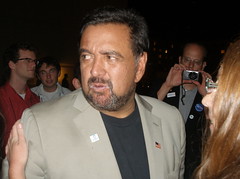February 25, 2010
Bill Richardson is down. Diane Denish is up, but Pete Domenici Jr. would fare better against her than any of his fellow Republicans.

Those are the conclusions of a poll on New Mexico gubernatorial politics by the North Carolina-based Public Policy Polling released Wednesday.
State Republicans tried to throw cold water on the poll results — referring in a news release to "liberal data" from a "Democratic firm" (PPP indeed works exclusively for Democratic candidates and organizations. I'm not sure whether this makes their data "liberal.") Meanwhile, a spokesman for the Democratic governor said PPP "relies on unscientific polling methods with untrustworthy results."
But New Mexico pollster Brian Sanderoff said Wednesday that while he can't vouch for PPP's exact numbers, the "general trends" and "big picture statements" in the poll ring true.
The poll is based on surveys of 990 New Mexico voters from Feb. 18 to 20. The survey's margin of error is 3.1 percent. The "interviews" are automated. A recorded voice reads the questions while the participant answers by pressing numbers on the phone.
Sanderoff has said that automated polls tend to undercount undecided voters — because those not interested tend to hang up on robots. Also, he said out-of-state pollsters often have more Hispanics represented than the percentage who actually vote.
PPP director Tom Jensen defended his company, saying in an e-mail to state reporters and bloggers, "In 2008 PPP was the most accurate pollster in New Mexico, showing Barack Obama winning the state by 17 (percentage) points. No other pollster's final survey showed Obama winning by more than 10, and he ended up winning the state by 15."

Richardson numbers: According to PPP's blog, Richardson — who won re-election with nearly 70 percent of the vote — has become "one of the least popular governors in the country." The poll says his disapproval number is 63 percent; only 28 percent approve. Even among Democrats, only 42 percent approve while 47 percent disapprove.
Sanderoff said PPP's approval number seems low. He did a poll for the Albuquerque Journal in September that showed Richardson's approval at about 50 percent. A SurveyUSA/KOB TV poll from the same month showed that number at 47 percent.
But he doesn't doubt Richardson's numbers have sunk since September, mainly because of the "continued negative publicity regarding state investments and allegations of pay-to-play."
Richardson spokesman Gilbert Gallegos said in an e-mail he'd never heard of PPP. He noted that Richardson has had to make unpopular decisions "cutting spending and ordering employee furloughs in order to balance the budget."
Governor's race: The PPP poll shows Denish, the lieutenant governor, beating Domenici Jr. by a 5-point margin and leading the other four candidates by margins between 14 and 18 percentage points.
Unlike Richardson and the Republicans, the Denish campaign in an e-mail didn't question the results, noting Denish was ahead "even in this hostile political climate."
PPP attributes both Denish's showing and Domenici's to name recognition. "Denish is by far the best known of the candidates running," the PPP blog says. "Domenici is the only one of the Republicans who more than half of the state has an opinion about, although it's possible people could just be conflating him with his father." (Pete Domenici Sr. was a U.S. senator for 36 years.)
The campaign of another GOP contender, Susana Martinez, concurred regarding Domenici's name recognition but attacked other aspects of the poll.
"It is highly suspect that all the Republican candidates have net negative image ratings at this point in the campaign. While it is expected that the Republican candidates would have low name ID and soft image ratings, it is not believable that they have achieved this net negative rating without a campaign having been meaningfully launched against them."
Sanderoff agreed, saying it's hard to believe that little-known candidates could have unfavorable numbers in the 20 percent range.
One thing everyone agrees on: It's still early.




